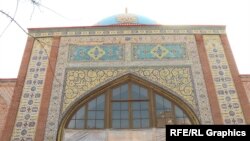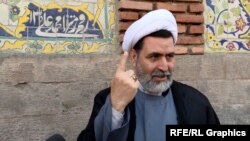The two pro-government lawmakers arrived in Armenia earlier this week to attend a session of a parliamentary assembly of the European Union and ex-Soviet states involved in the EU’s Eastern Partnership program.
While in Yerevan, they also visited the city’s Blue Mosque and later posted on social media photographs of themselves sanding at its picturesque courtyard. Both men wrote that the Muslim shrine is the “sole Azerbaijani monument” preserved in the Armenian capital and expressed confidence that its “real masters” will be able to pray there soon.
The Iranian Embassy in Armenia hit back at the Azerbaijani deputies on Wednesday in a series of tweets written in Armenian, Persian and English. It also posted photographs of Persian-language inscriptions on the walls of the mosque and adjacent structures.
“The Blue Mosque, a symbol of Iranian art, has been active again in the last 3 decades as the praying and congregation place of Muslims residing in Armenia and a touristic attraction,” wrote the embassy.
“A great pleasure that its centuries-old Persian epigraphy has been preserved! Who can read them?” it said in English.
Mahmoud Movahedifar, an Iranian clergyman serving there, made the same point as he showed RFE/RL journalists around the mosque on Thursday. He insisted that it has distinctive features of Iran’s traditional Islamic architecture.
“What language is this: Persian or Azeri?” he asked. “Even if there was a single tile here with an Azerbaijani inscription we would recognize that fact.”
“If those gentlemen claim that this is an Azerbaijani mosque then let them show one trace of Azerbaijani history here,” he said.
Azerbaijani President Ilham Aliyev has repeatedly described Yerevan and other parts of Armenia as “historical Azerbaijani lands.”
Movahedifar complained that neither he nor other people working in the mosque were informed about the Azerbaijanis’ visit beforehand.
“Had I known about their visit, I would have immediately come here and shown them all this evidence and said: ‘If you say it’s Azeri, show me a single piece of evidence,’” he said.
The Blue Mosque was built in 1766 at a time when most of the territory of modern-day Armenia was part of the Persian Empire. It was shut down by Soviet Armenian authorities in the mid-1920s. Its buildings and courtyard were used for mostly secular purposes in the following decades, up until the collapse of the Soviet Union.
The mosque complex was reopened as a religious institution in 1996 after being thoroughly renovated by the Iranian government in line with an agreement with Yerevan’s municipal administration. It now also houses an Iranian library and cultural center.

